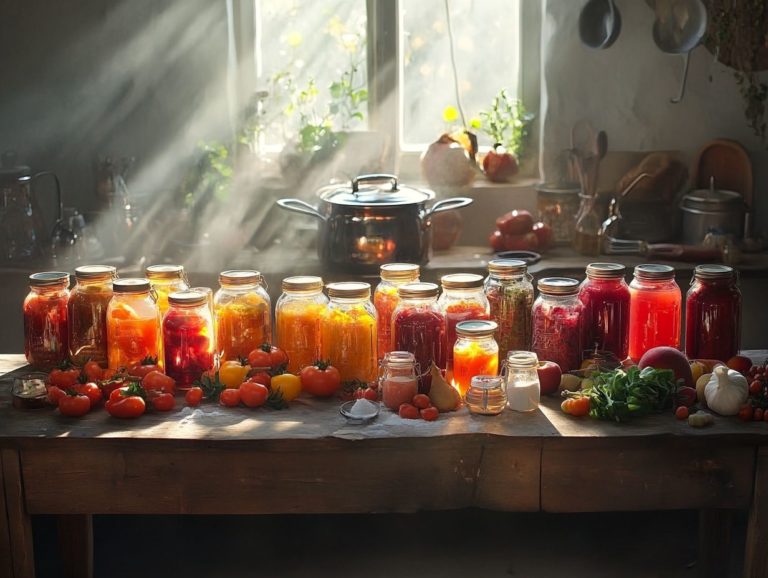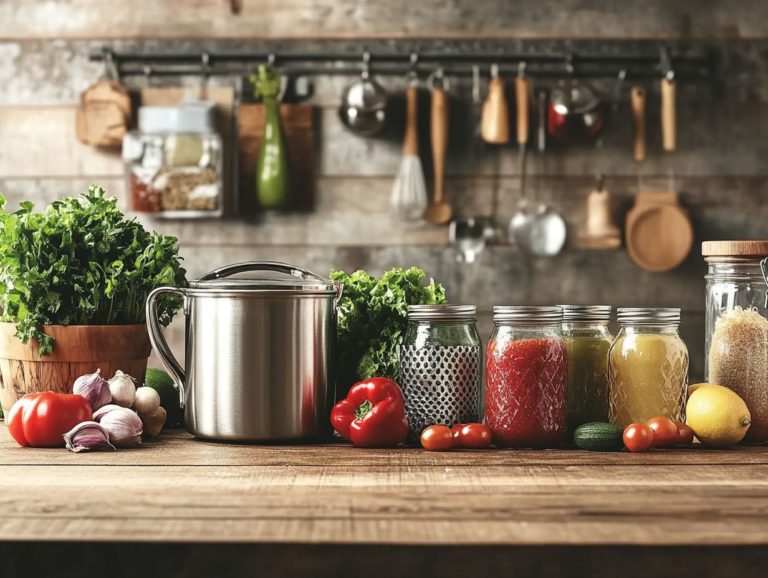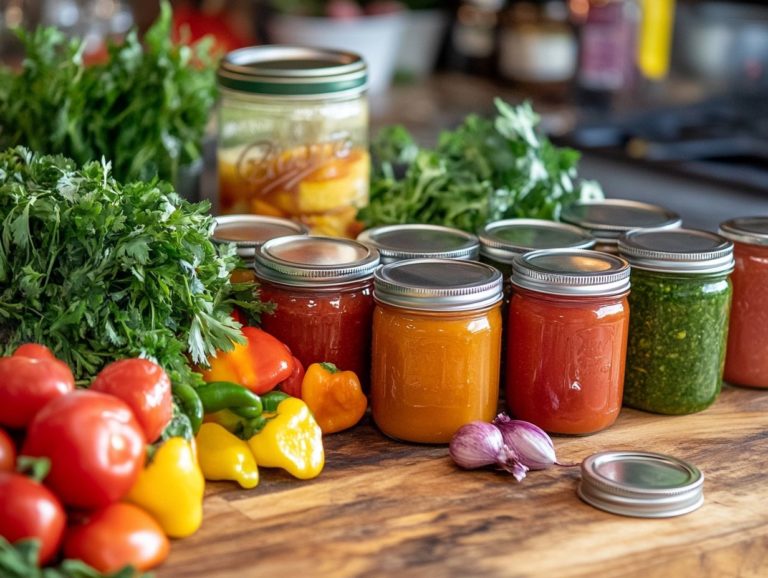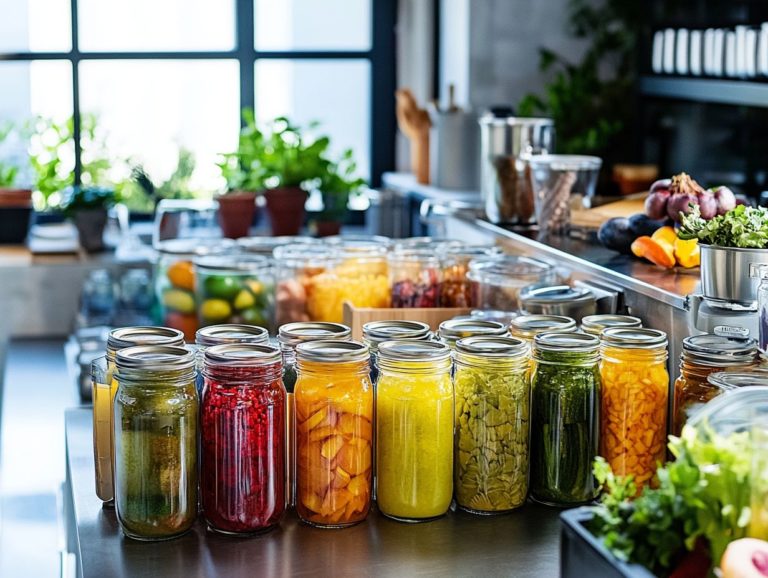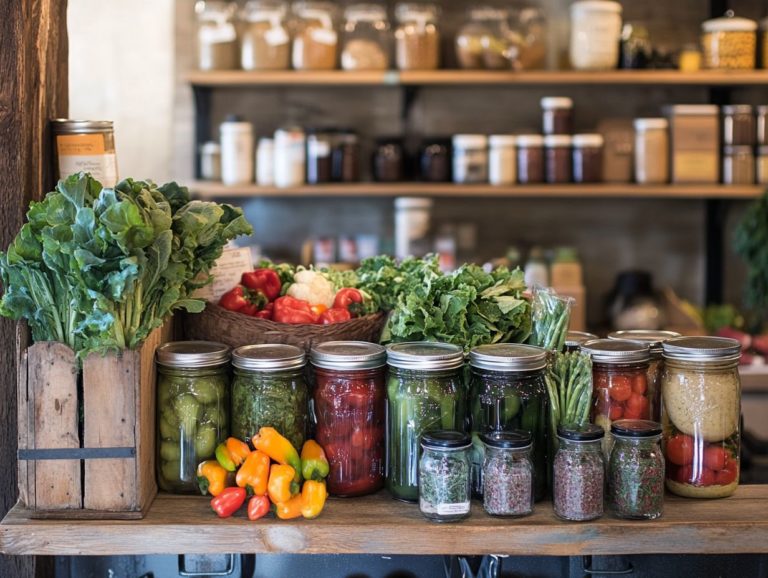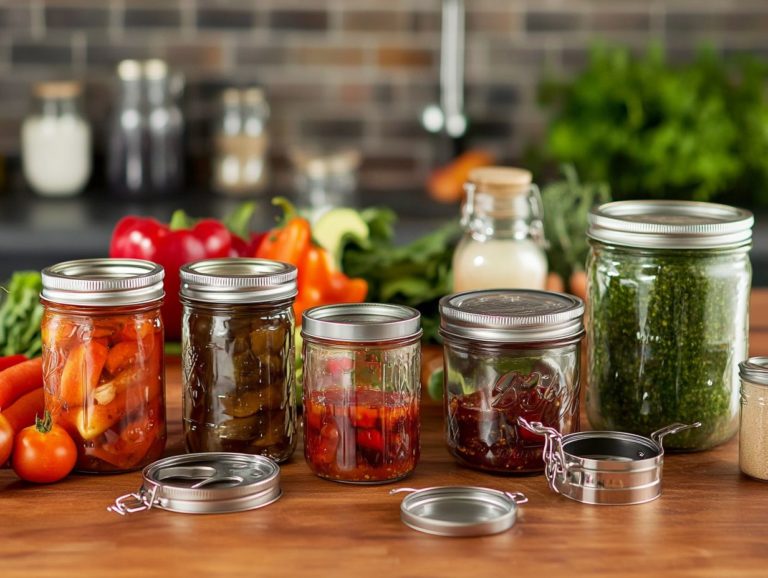Essential Safety Checks for Canning Equipment
Canning offers a rewarding opportunity to preserve your homemade goods. However, ensuring safety throughout the process is crucial!
This guide will walk you through essential safety checks, such as cleaning and sanitizing your equipment and inspecting jars and lids for any signs of damage. It also delves into how to test pressure canners for functionality and proper sealing, along with tips on safe canning practices.
Discover the best methods for storing your canned goods to maintain their freshness and deliciousness. Don t wait! Start your canning preparations today to keep your food safe!
Contents
- Key Takeaways:
- Why Safety Checks are Important
- Preparing for Canning
- Inspecting Canning Jars and Lids
- Testing Pressure Canners
- Ensuring Safe Canning Practices
- Storing Canned Goods
- Frequently Asked Questions
- What are essential safety checks for canning equipment?
- Why is it important to conduct regular safety checks on canning equipment?
- How often should safety checks be performed on canning equipment?
- What should be included in a safety checklist for canning equipment?
- Are there any specific safety precautions that should be taken when using canning equipment?
- What should I do if I encounter any issues or concerns during a safety check of my canning equipment?
Key Takeaways:
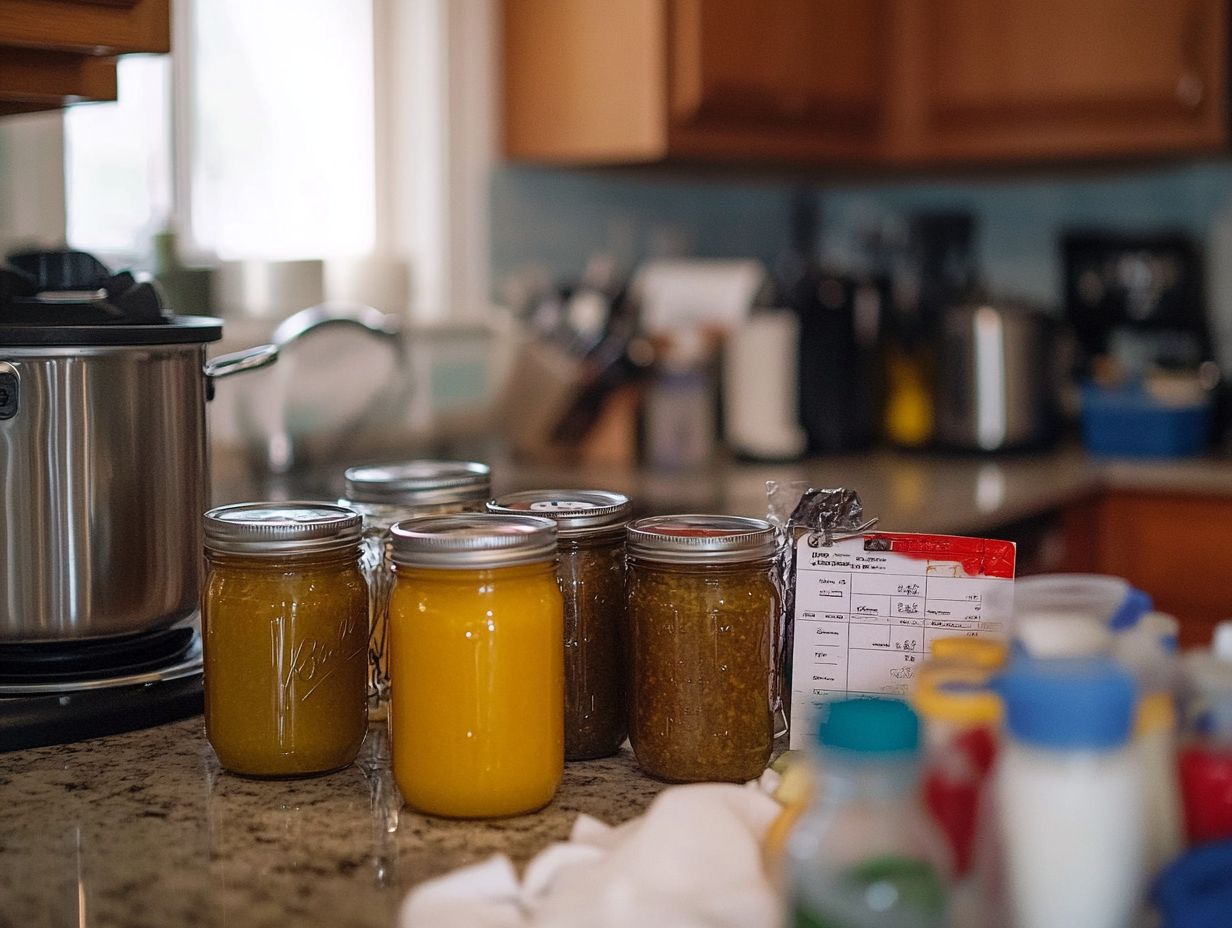
- Regular safety checks are crucial for safe canning and preserving foods.
- Proper cleaning, inspecting, and testing of canning equipment is essential before use.
- Adhering to recommended guidelines and proper storage techniques ensures the safety and quality of canned goods.
Why Safety Checks are Important
Safety checks are essential in the realm of food preservation, particularly during canning season. They play a crucial role in preventing foodborne illnesses, which are diseases caused by contaminated food, including potentially devastating outbreaks linked to the bacteria Clostridium botulinum, known for causing botulism.
For those who embark on the journey of home food preservation, ensuring food safety is of utmost importance. Improper canning practices can pose serious health risks. Trusted institutions like Oklahoma State University emphasize following USDA guidelines during the canning process to safeguard the nutritional integrity and safety of preserved foods.
Preparing for Canning
Preparing for canning involves following important steps to ensure your canning equipment, whether it’s boiling-water canners or pressure canners, meets the key features to look for in canning equipment and is in optimal working condition.
This preparation goes beyond just cleaning your canners. It also includes the careful selection of canning jars and ensuring you have all the essential canning utensils ready for efficient food preparation. Additionally, it’s important to recognize signs you’re using faulty canning equipment to avoid any issues during the process.
Cleaning and Sanitizing Equipment
Cleaning and sanitizing your canning equipment is vital for ensuring food safety. This process effectively prevents contamination during canning. Properly cleaning your canning utensils and equipment removes residues and eliminates potential bacteria that could threaten the quality of your canned goods.
Choosing the right cleaning agents is essential. Use food-safe detergents that effectively cut through grease and grime without leaving harmful residues. Sanitize with a diluted bleach solution or a specialized sanitizer to ensure all surfaces are free from pathogens.
Don t forget to check those often-neglected areas, like lids and rims, where unwanted microbes can hide. By following these best practices, you can enjoy peace of mind knowing your canned foods are produced in a safe and hygienic environment, which enhances the quality and longevity of your home-preserved goods.
Inspecting Canning Jars and Lids
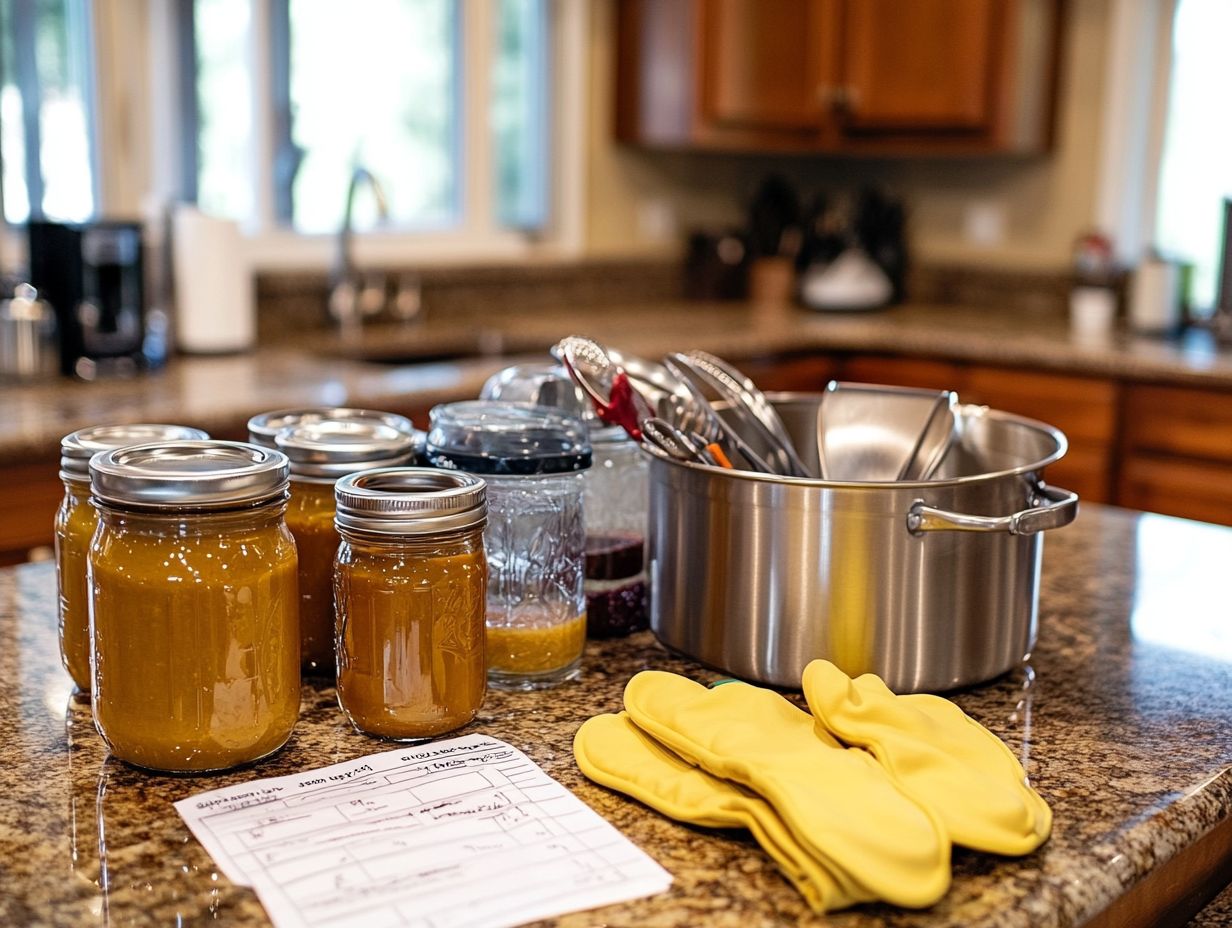
Inspecting your canning jars and lids is vital for ensuring a proper seal, which is critical for the long-term storage of your canned foods. As you prepare for canning, take a moment to examine each canner lid for any signs of damage, including a worn rubber gasket. Additionally, it’s important to know how to properly clean canning equipment to maintain their effectiveness.
Addressing these issues is essential, as they can jeopardize food safety and lead to spoilage.
Signs of Damage or Wear
Recognizing signs of damage or wear in your canning jars and lids is essential for maintaining food safety. Compromised seals can lead to spoilage and even foodborne illnesses, which no one wants. Keep an eye out for small cracks, chips, or dents in your canning jars. Also, ensure the rubber gasket on your canner lid is intact to prevent leakage during the canning process.
Inspect the jar rims for nicks, as even slight imperfections can hinder the formation of a solid seal. Your lids should be free of rust or discoloration; these are red flags indicating they may no longer be effective. Regularly replacing damaged canning materials enhances sealing ability and significantly contributes to the overall safety of your canned goods.
By staying vigilant about the condition of your canning supplies, you ensure the fruits of your labor remain safe and enjoyable for your family long after they ve been stored.
Testing Pressure Canners
Testing your pressure canner is key to ensuring your food is safe! Accurate pressure levels are vital for eliminating harmful bacteria, especially in low-acid foods.
Regularly test your gauge and use a canning thermometer to ensure your pressure canner operates flawlessly, maintaining the right temperature. This proactive approach helps safeguard your culinary creations from foodborne illnesses.
Checking for Proper Sealing and Functionality
Checking the sealing and functionality of your pressure canner is essential for a successful canning experience. This ensures your food remains safe for consumption. After you’ve completed the canning process, inspect each jar’s seal and confirm that every lid is firmly adhered to prevent air from sneaking in. Utilizing the right tools, such as those outlined in the essential tools every home canner needs, can further enhance the safety of your canned goods.
To verify the seal, perform the ‘pop’ test: gently press down in the center of the lid. If it stays down without bouncing back, you ve got an intact seal. If it pops back up, that s a red flag indicating a potential sealing issue that you must address promptly.
Examine your jars for signs of leakage or bulging to reassure you of the safety of your preserved items. By following these steps, you maintain the quality of your food and help prevent spoilage and bacterial growth, ensuring long-term food safety.
Ensuring Safe Canning Practices
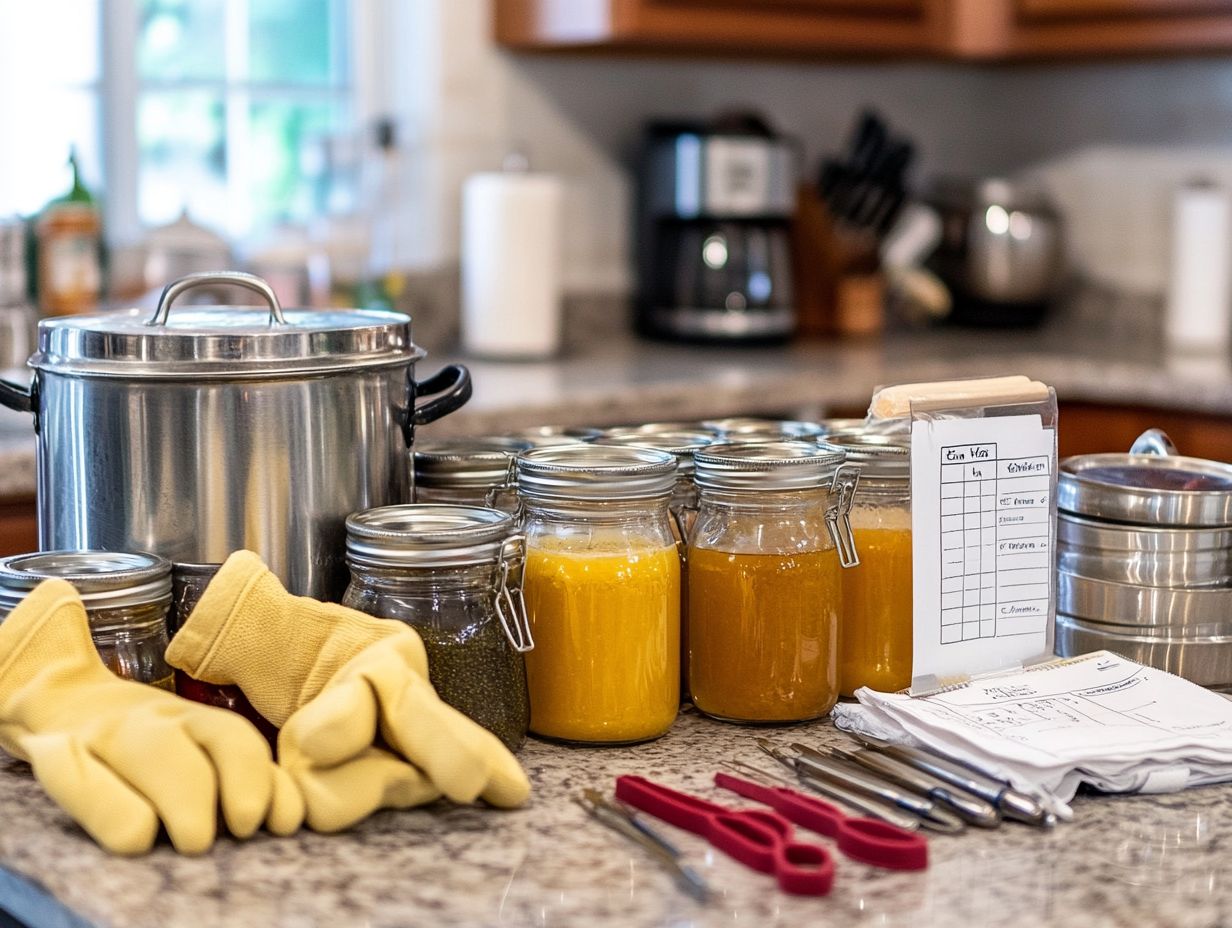
Ensuring safe canning practices is crucial for your home food preservation efforts. This significantly reduces the risk of foodborne illnesses and safeguards nutritional integrity. Follow USDA processes and expert guidelines from Master Food Preservers to confidently embrace best practices for preserving both high-acid and low-acid foods.
This approach enhances your culinary creations while prioritizing your health and safety, maximizing the benefits of your home gardens.
Following Recommended Guidelines
Following recommended guidelines for canning is essential to guarantee food safety and preserve the nutrients in your canned goods. By adhering to USDA processes and tapping into the expertise of Master Food Preservers, you can minimize the risk of foodborne illnesses while maintaining the delightful flavors and quality of your homemade preserves.
If you’re venturing into fruit canning, select ripe, high-quality produce to maximize both flavor and nutrient retention. Techniques like hot packing play a key role in preserving that perfect texture and taste.
For vegetables, pressure canning is typically the best method since most vegetables are low in acidity and can spoil easily.
To elevate the health benefits of your canned goods, consider blanching vegetables briefly before canning. This simple step enhances color and flavor while helping to retain essential vitamins.
Using preheated jars can further contribute to nutrient preservation, ensuring every jar captures the very essence of your harvest.
Storing Canned Goods
Properly storing canned vegetables is crucial for maintaining both the quality and safety of your preserved foods. This allows them to remain suitable for consumption long after the canning process.
By using effective storage techniques, such as vacuum packaging and keeping your cans in a cool, dark space, you can extend the shelf life of your canned food while preserving its flavors and nutrients.
Proper Storage Techniques
Using the right ways to store canned food is essential for both longevity and safety. Keep your cans in a cool, dark place, away from direct sunlight and humidity.
You can also use vacuum packaging to help retain the quality and nutritional safety of your preserved goods. Beyond temperature control, it s important to organize your cans by type and expiration date, creating an efficient system for usage.
Labeling each can with the purchase date simplifies rotation, ensuring that older items are consumed first. Storing cans on shelves rather than the floor protects them from potential damage.
For optimal results, maintain a well-ventilated storage area to prevent moisture buildup, which can compromise the integrity of your cans.
These smart practices can really boost the shelf life of your canned goods and make it easier for you to access them when cooking or meal prepping.
Frequently Asked Questions
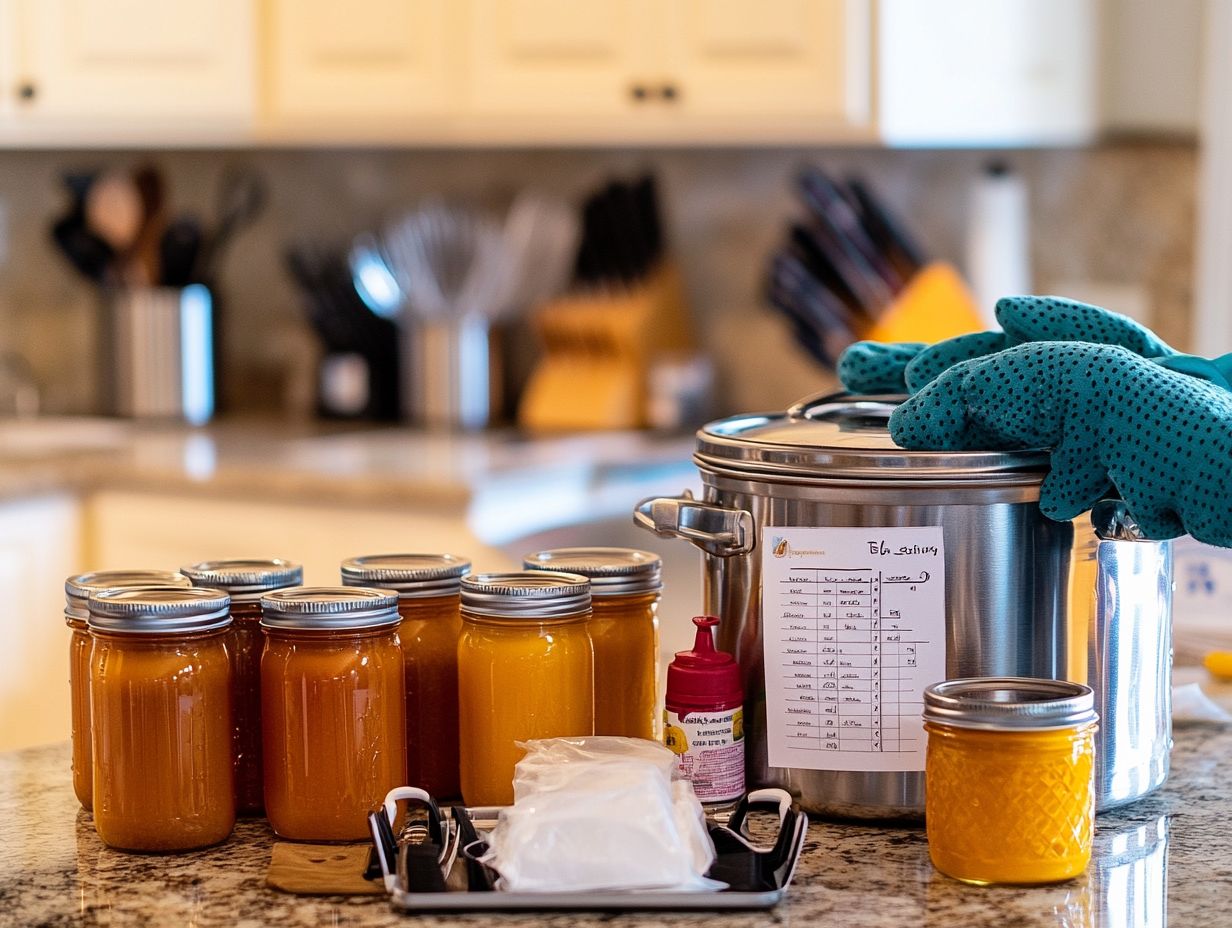
What are essential safety checks for canning equipment?
Essential safety checks for canning equipment include inspecting for any damage or wear, ensuring all parts are in proper working condition, and confirming that safety features, such as pressure release valves, are functioning correctly.
Why is it important to conduct regular safety checks on canning equipment?
Regular safety checks ensure that canning equipment is in proper working condition. For more information, see this guide on how to maintain your canning equipment. This reduces the risk of accidents and ensures the safety of both the operator and the food being canned.
How often should safety checks be performed on canning equipment?
Safety checks should be performed before each use of the canning equipment, as well as periodically throughout the canning season to ensure continued safety and proper functioning. For detailed guidance, refer to this resource on how to evaluate used canning equipment.
What should be included in a safety checklist for canning equipment?
A safety checklist for canning equipment should include items such as inspecting for damage or wear, checking for proper functioning of safety features, and ensuring all parts are securely in place, along with using essential safety gear for home canning.
Are there any specific safety precautions that should be taken when using canning equipment?
Yes, it is important to follow the manufacturer’s instructions and recommendations for safe use of canning equipment. This may include wearing protective gear, such as gloves and goggles, and ensuring proper ventilation in the canning area.
What should I do if I encounter any issues or concerns during a safety check of my canning equipment?
If you have any concerns about the safety of your canning equipment, do not use it until the issue has been addressed. For proper guidance, refer to the essential guide to canning safety and contact the manufacturer for assistance or have a professional inspect and repair the equipment if necessary.
Stay safe and enjoy your canning adventures!

